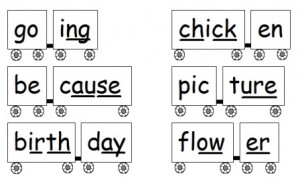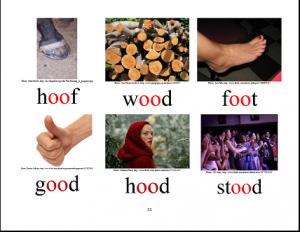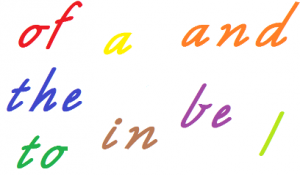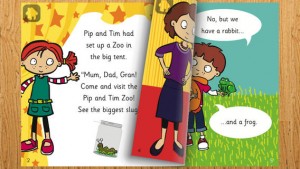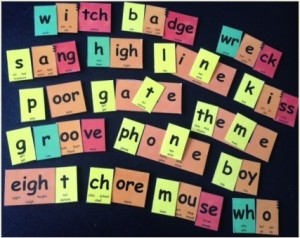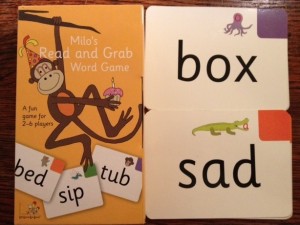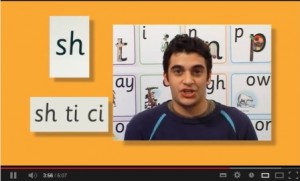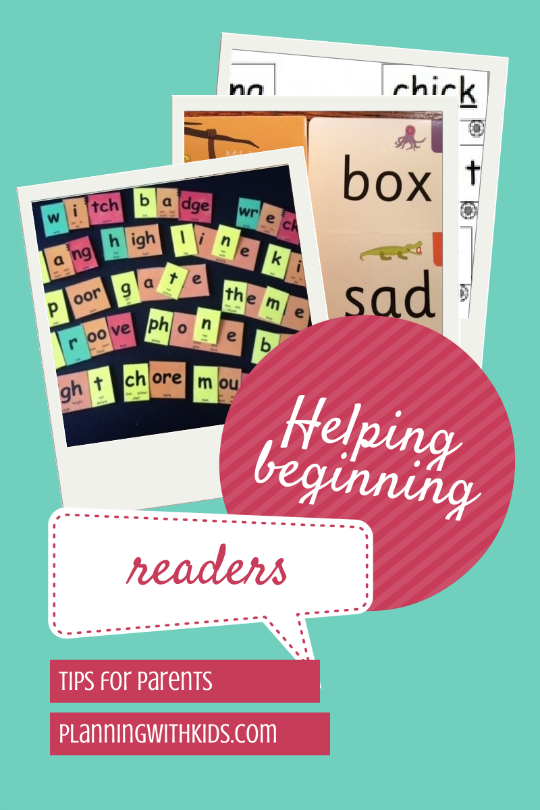
This week on the blog I will be featuring posts on the theme of supporting kids’ learning. You can read other posts in this series here:
The post is written by a Melbourne Speech Pathologist, Alison Clarke. I have known Alison for over 10 years and she has a fab blog called Spelfabet which focuses on helping kids learn the building blocks of words – sounds and their spellings. I would highly recommend her professional services if you are in the Clifton Hill (Vic) area of Melbourne.
***********
One of the cutest things at school at this time of year is the five-year-olds with their bed hair, hilarious questions, and huge eyes, hats and bags. They follow teachers in wonky lines along school corridors like downy ducklings, learning to be school kids.
They all know one of the main things they’re at school to do is learn to read. I’ve never actually heard a child answer, “How was your first day at school?” with the apocryphal, “It was OK, but I can’t read yet”, but I wouldn’t be at all surprised.
A few lucky kids can already read before they start school, and most have grasped the basics by the end of their first year, but about one in five still currently struggle and need extra help.
One in five is a lot. If one in five aeroplanes failed to take off or crashed, that would be the end of aeroplanes.
How do you make sure your kid gets off the ground in reading, and then keeps going up?
What do beginning readers need to know?
To get going at reading and writing, you need to know:
- How to listen and speak,
- Lots of words (vocabulary),
- How written materials work e.g. what a book is for, that we start reading at the top of the page and work left to right along each line.
- That spoken words are made of sounds.
- That letters are how we write speech sounds down.
- How to recognise letters, regardless of case or writing style:
Aa Aa Aa Aa Aa
- How to pull words apart into sounds, and smoosh them back together into words,
- That we have more sounds (44) than letters, so sometimes we combine 2, 3 or even 4 letters to spell a sound, e.g.
- The “ch” in “chip” or the “ou” in “out”,
- The “dge” in “ridge” or the “igh” in “fight”,
- The “eigh” in “weigh” or the “ough” in “drought”.
- That English is a mishmash of many languages (see the Open University’s hilarious History of English in 10 minutes), so most sounds are spelt in more than one way (e.g. the vowel sound in “hear”, “beer”, “here” and “pier”) and many spellings represent more than one sound (e.g. the “ear” in “hear”, “learn”, “bear” and “heart”).
- How to hold a pencil and form letters correctly.
What do beginning readers and spellers need to do?
Like driving a car, playing a musical instrument and other skilled behaviours, reading and spelling require not just theory, but also practice.
We accept that learner drivers need to kangaroo-hop around car parks to get mastery of a vehicle before they can really drive anywhere interesting, and learner musicians need to do scales and stuff before they’re ready to play real music in a real performance. Yet too often children are expected to read “real books” before they have had a chance to master the mechanics of reading and spelling. This sets them up to fail.
At first, just getting words off and onto the page takes up 100% of a child’s cognitive resources, and if too many sounds and letters are introduced at once, many kids simply get overwhelmed.
They need to start off with just a small number of sounds and letters, and practise reading and spelling them in little, simple words. Once these are mastered, a few more sounds and letters can be added, and then a few more, until all the main patterns are covered and the child can confidently tackle any word. The name for this teaching methodology is Synthetic Phonics.
Is this how early literacy is taught in schools?
It depends. Some early years programs do use Synthetic Phonics, but more often a mixture of other teaching methodologies is used.
Children are often encouraged to memorise high-frequency words, such as the words “a”, “the” and “was”, while at the same time being taught the alphabet, along “A is for apple, B is for banana” lines, focussing on first letters.
Many diligent children study their high-frequency words list (containing words like “a” and “was”), and the letter “A” words on their classroom poster – “a” is for “apple”, “aeroplane”, “aardvark”, “apricot” and “autumn”, and end up none the wiser about what sound or sounds the letter “A” represents.
That’s because the letter “A” represents a different sound in each of these words, sometimes in combination with other letters:
- A as in “a book” (pronounced “uh”)
- A as in “was” (pronounced “o”)
- A as in “apple” (pronounced “a”)
- AER as in “aeroplane” (pronounced “air”)
- AAR as in “aardvark” (pronounced “ar”)
- A as in “apricot” (pronounced “ay”)
- AU as in “autumn” (pronounced “aw”)
Some teachers encourage children to guess words by looking at the first letter and picture, or even tell children not to sound out words. Unfortunately few teachers have ever been taught much about sounds and letters, and schools often lack Synthetic Phonics teaching resources.
Teachers are quite understandably doing what they’ve been taught and equipped to do, but the reading research has moved on.
Ideally children should nail down one or two main spellings for 42 of the 44 sounds in short, simple words (not “zh” as in “vision” or the unstressed vowel, as these are mainly in longer words), and not only at word beginnings, before introducing additional spellings in a systematic way.
A whole-school spelling curriculum (such as the Australian program Sound Waves) is also a good idea, because it makes sure children aren’t taught some spellings every year, and others not at all.
How can I help my child(ren)?
- Language: Have lots of conversations, and read them lots of books, to build their listening and speaking skills, and in particular vocabulary. Hopefully you’ve been doing that for years anyway, in which case give yourself an enormous tick, a gold star and an elephant stamp.
- Decodable books: these are books that start off with just a few simple spellings. Click here for a list of the ones I know of, and please tell me if you know of others. These should be the first books children try to read themselves.
- Build words with letters: Use movable letters to make small, simple words and show how letters can be moved around to make different words e.g. the sounds in “pan” can be swapped around to make “nap”, and you can change the “a” for an “i” to get “nip”.
- Games: There are plenty of good synthetic phonics apps out there – click here for my list, apologies that I know most about iPad apps as that’s the only tablet I have. Although the wonderful Phonics Hero iPad app is not currently available, you can still get it as a computer program.
- Copying: Copying is a useful activity for beginners, because it lets children write what they want to write without practising spelling mistakes, and allows them to focus on letter formation.
- Sounds are more important than letter names: When reading, tell children the sounds represented by any letters/spellings they don’t know, in preference to the letter names. I wish I had $100 for every time I have asked a child to write a word like “well” and they wrote “WL”, or “car” and they wrote “CR”.
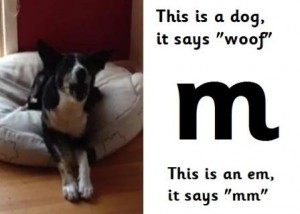 Crisp sounds: adults often say sounds in a sloppy way e.g they say “suh” instead of “s” and “puh” instead of “p”. See this blog post for a video of how to say most of the sounds.
Crisp sounds: adults often say sounds in a sloppy way e.g they say “suh” instead of “s” and “puh” instead of “p”. See this blog post for a video of how to say most of the sounds.
The main ones I use with school beginners are Little Learners Love Literacy, Sounds Write, Dandelion and Fitzroy Readers, while with older strugglers I tend to use the Magic Belt, Totem, Alba and Talisman readers and the Sounds Write Chapter Books. If money is an object, the ARI and BRI books are fabulous value at about $2 each, and the SA SPELD phonic books can be downloaded to a computer or tablet for free.
There are also some books as apps: Bob Books, First Grade Reading Program and Starfall Learn To Read are my favourites. Always encourage children to sound words out from beginning to end, not look at the first letter and the picture and guess.Some movable alphabets include more than just 26 letters, including my own “100 first spellings” one, which you can download, print and laminate yourself, then stick magnetic tape on to make fridge magnets. It comes with a suggested list of first words to build.
There are also a lot of good word-building apps available for the iPad, such as WriteOn Phonics, Preschool University Spelling 1-4, Little Speller and Oz Phonics 2 and 3.Games like Milo’s Read And Grab Game and Trugs are also fun ways to practice reading in a carefully-graded way.If your child wants to write a card or letter to someone, get them to dictate to you what they want to write (either the whole lot, or just the words they don’t know how to spell), which they can then copy. Don’t leave them floundering to write words they don’t yet know how to spell, and potentially getting them wrong and committing these errors to memory.If you must teach tiny kids the letter names, distinguish clearly between names and sounds. One way to do this is with an animal analogy e.g. show them a picture of a dog and say “this is called a dog, its sound is woof woof” then show them a letter “b” and say “this is called a bee, its sound is b”. Click here for more on this.
What should parents do if a child still struggles?
- Don’t “wait and see”. While your child is waiting around, most of his or her classmates are taking off. The longer your child is left behind, the harder it will be for them to catch up.
- Seek an expert assessment by someone who can tell you exactly what the problem(s) are and what to do about them. Some children have Specific Language Impairment (see the RALLI campaign for details), some children struggle to discriminate sounds or learn letters and spelling patterns, and some have other difficulties. The school Speech Pathologist or Psychologist should be able to either do an assessment or help you find someone else who can.
How are your children are taught early literacy at their school?

